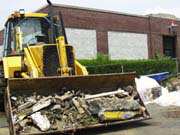A lack of time could delay the expansion of the town’s two grammar schools, although school officials are seeking to have the projects put on “the fast track.” “We’re still hoping to have the project started by September,” said Board of Education member Anthony Rinaldi, who is the chairman of the board’s Buildings and Grounds Committee and the man overseeing the project’s development. “The drawings for expansion are 40 percent complete. The architect has six full-time architects working on the project, and hopes to have the plans ready by the beginning of August.” The time frame for approval is extremely tight. The school district is planning to build an addition to both of the existing elementary schools, working simultaneously with the hopes of having the schools ready by September of 2001. But this is a 12-month project and if the contractors are not hired and the work not begun by September of this year, it is unlikely the schools will have access to the available space by the deadline, Rinaldi said. Rinaldi said the district is hoping to speed up the usual time frame for approving the project. While engineers are already on site doing test borings of the soil, the plans themselves must be presented to the state Department of Education for approvals and comments. “This normally can take four to eight weeks,” Rinaldi said. “We’re hoping we can get the state to approve the project in a week.” This would leave the board a month to put out bid requests and eventually award the contract. Normally, this process can take four or more weeks as well. Rinaldi hopes that if everything goes well, the contractor can be on-site doing preliminary work by the end of September. “If the state takes longer, then we won’t get it done,” Rinaldi said. While Rinaldi said he would like to hurry the architects and have them give him the completed plans before the first week of August, he added that this is a critical stage and that the designers simply can’t be rushed and still have the plans function as needed. He said electrical systems, ductwork and steel frames must be designed to complement each other. “We can’t have electrical systems coming up in the middle of columns or ducts going into steel beams,” he said. “But once this phase of the work is done, the project will move along more quickly. While we’re only 40 percent done now, in a week or two we might be 80 percent finished with the plans.” Was approved by voters in April The $6.9 million project – presented to the public for the first time last January – posed some significant challenges to the designers. Clarendon School, designed in the 1960s, is a group of round buildings or pods with connected passageways. Under the proposal, this pod would be connected to the rest of the school, and an additional more traditional building would be constructed in the lawn area on the west side of the existing school. This section would also be connected by passageway to other pods. Architect Jamil Faridy said the external work can be done over the summer when construction would least affect school activities, with the interiors completed before the addition is attached to the rest of the school. Huber Street School – which is one of the older buildings in Secaucus – will get a single-floor addition that will take the space currently used as the school’s parking lot. The construction bond would also include work on existing media centers in schools and on creating a computer room separate from the library in Huber Street School. As with the Clarendon School addition, the addition at Huber Street will include a second floor if future needs require the school to expand again. The installation of a new roof for Clarendon School is on an even shorter time frame. While roofing is part of the $6.9 million construction bond passed by the voters in April for school expansion, the project has been being treated separately. Two weeks ago, the Board of Education awarded the bid for the work, which is scheduled to begin shortly. Board member Paul Amico, however, was concerned about whether or not the project could be completed by the opening day of school this September, fearing work continuing while kids are in school. A similar situation occurred at the high school several years ago when the fumes from hot tar invaded the ventilation system and forced officials to send the students home. Rinaldi said the Clarendon School project would be using a rubber roof rather than hot tar, making the issue of fumes moot. But Amico said the workers would need to use torches to seal the seams, something he had a concern about. “These are handheld touches,” Rinaldi said. “They have a neat and safe operation and pose no risk to kids.” Board member Ed Rittberg also noted that work on the schools will not be done when student are present but after school hours and on Saturdays.
Our Digital Archive from 2000 – 2016
